Bruxism might sound like a complex term, but it's simply a way to describe when you grind or clench your teeth. People often do this in their sleep or during stressful times, and it’s more common than you might think. Bruxism can lead to several issues, like headaches, jaw pain, or worn-down teeth. That's why it’s crucial to know about the different options for managing bruxism. The good news is that there are several ways to tackle this condition, making it easier to maintain both a healthy smile and peace of mind.
Taking a closer look at bruxism involves understanding its symptoms and the various approaches to managing it. With several treatment options available today, from simple lifestyle changes to more advanced medical treatments, there's much to explore. Deciding which option suits you best depends on your situation, symptoms, and preferences. This article delves into these different choices and how they can help you or someone you know deal with bruxism effectively.
Identifying the Symptoms of Bruxism
Recognising bruxism is the first step toward addressing it. With a range of symptoms that can vary between individuals, knowing what to look out for is key. Here are some common signs and symptoms that may indicate bruxism:
- Teeth grinding or clenching, which may be loud enough to wake up your sleeping partner
- Flattened, fractured, or chipped teeth
- Increased tooth sensitivity
- Jaw or neck pain
- Dull headaches, usually in the temples
- Damage from the inside of your cheeks from chewing
One way you can identify bruxism is by observing these symptoms, especially if they happen regularly. For instance, if you find yourself waking up with a sore jaw repeatedly, it could be a sign. If your partner mentions hearing grinding noises while you sleep, this is another possible indicator. While these signs don't always mean you have bruxism, they are good reasons to seek professional advice.
Being attentive to these symptoms allows you to catch the problem early and explore various treatment options. The good news is that identifying bruxism doesn’t require any fancy tests. Simple awareness and observation play a big role in recognising this condition. This understanding can lead to more effective management before the symptoms lead to more severe complications.
Treatment Options for Bruxism
Once you've identified the signs of bruxism, considering treatment options comes next. There are several approaches available, tailored to suit varying needs and severity.
One common and convenient treatment is using over-the-counter mouthguards or dental splints. These devices help protect your teeth from the grinding forces during sleep. They’re custom-fitted by a dentist to ensure comfort and effectiveness. While they don't stop bruxism, they can prevent damage to your teeth.
Prescription medications can sometimes aid in managing bruxism. Muscle relaxants may be prescribed to help ease jaw tension and reduce grinding. In cases where anxiety contributes to bruxism, certain anti-anxiety medications can be beneficial.
Another helpful approach involves stress management techniques. Stress often triggers or worsens bruxism, so finding ways to manage stress can be crucial. Relaxation exercises, such as yoga or meditation, can help calm the mind and reduce the likelihood of teeth grinding. Lifestyle changes, like establishing a routine and incorporating regular exercises, can also have a positive impact.
Advanced Bruxism Treatments
For those with severe bruxism, advanced treatments might be necessary. Among these, Botox injections are gaining attention. Botox can be used to weaken overactive jaw muscles, which helps alleviate grinding and clenching. It’s often seen as a reliable option when other treatments haven’t achieved the desired results.
Dental interventions like orthodontics or restorative procedures can also play a role in managing bruxism. For example, if misaligned teeth contribute to one's teeth grinding, orthodontic treatments might help correct the issue. Restorative treatments, like crowns, can address and repair teeth that have been damaged due to severe grinding.
Seeking Professional Help
Knowing when to seek professional help is an essential aspect of managing bruxism. While some might find relief through over-the-counter solutions or stress management, others may need more comprehensive care. Consulting a dentist or a specialist can provide a clearer picture of the situation and guide you through available options.
Finding a treatment plan that’s right for you may also involve visits to clinics with expertise in bruxism. Specialists can provide tailored advice and options best suited to your needs, ranging from basic solutions to more advanced treatments.
Navigating Your Path to Relief
Navigating the variety of bruxism treatments can seem overwhelming, but understanding the choices can pave the way to effective relief. Starting with simpler options, like mouthguards and stress management, can offer immediate comfort and protection. Moving to more advanced treatments with professional guidance ensures that you receive care tailored to your condition’s severity.
Addressing bruxism not only helps maintain healthy teeth but also alleviates accompanying discomforts such as jaw pain and headaches. As you explore the best course of action, it’s important to remember that support from healthcare professionals can be invaluable, offering insights and expertise that lead to effective solutions.
If you’re experiencing symptoms of bruxism and are exploring ways to manage it effectively, you’re not alone. Practical solutions are available to help you find relief. To learn more about effective bruxism treatments, visit The Bruxism Clinic and discover how we can support you on your journey to better oral health and comfort.







